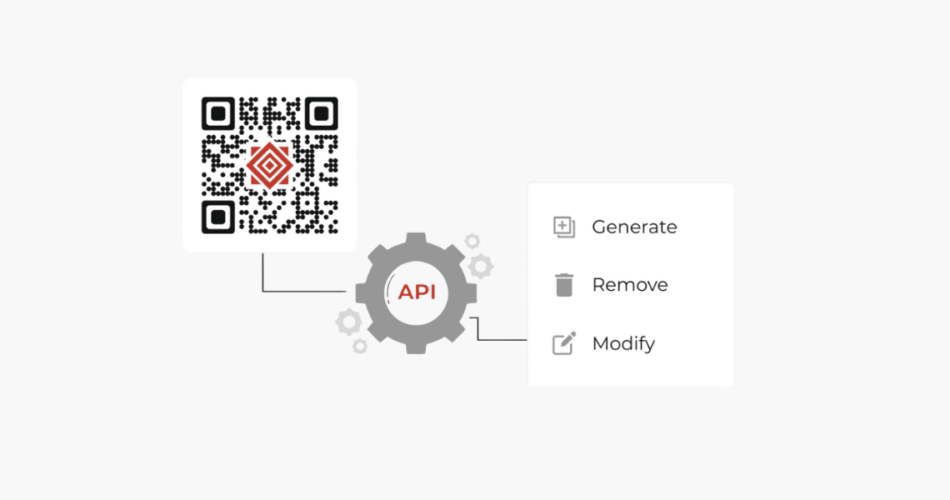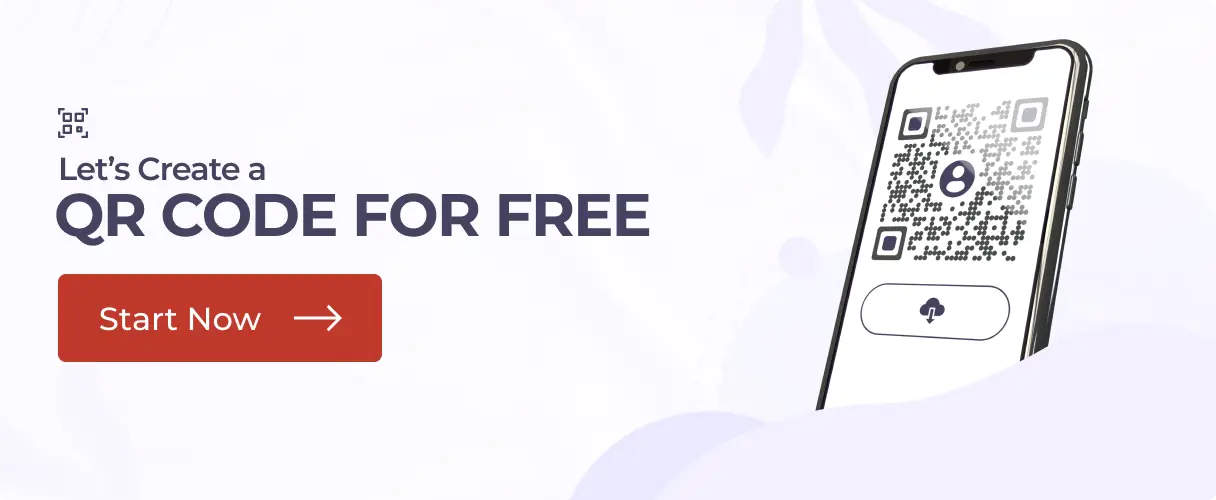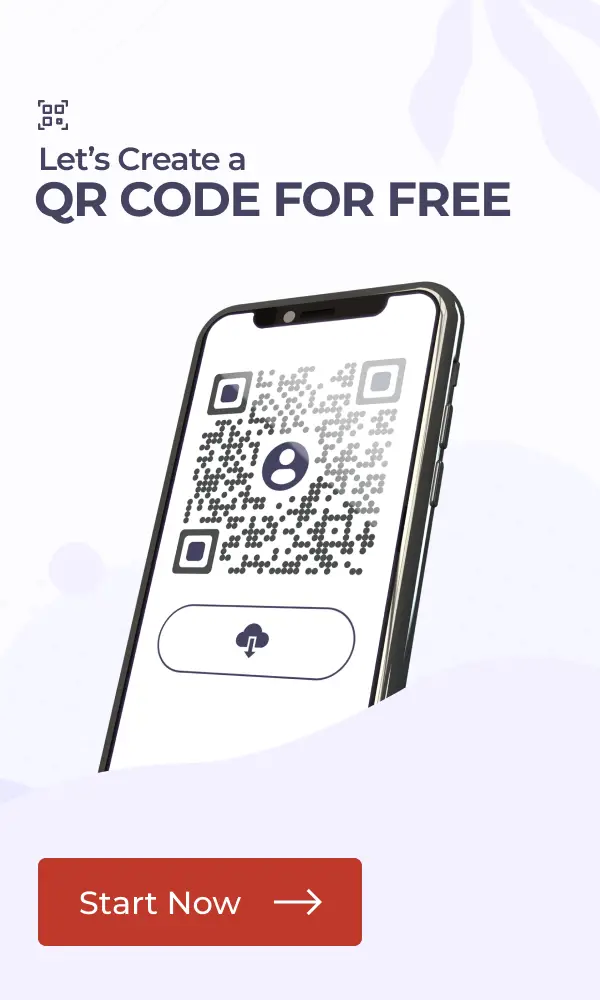In a nutshell: QR Code APIs enable developers and businesses to programmatically generate, customize, and manage QR Codes at scale. Platforms like Scanova QR Code Generator offer comprehensive API solutions with dynamic code creation, real-time analytics, custom branding, and enterprise-grade security. This guide covers implementation steps using a reliable tool, best practices, and how to choose the right QR Code API for your business needs.
QR Codes have evolved from simple black-and-white squares to powerful business tools that bridge offline and online experiences.
With over 11 million households scanning QR Codes, businesses need robust QR Code APIs to generate, customize, and manage these codes at scale.
If you are a business owner or a developer planning on using QR Codes in your information systems or business applications, you’d want QR Codes in bulk. Plus, you would want to be able to generate QR Codes in real-time for your end-users.
And here’s the thing: To do that, it’s not feasible for you to head on to your QR Code generator every time you need to create a QR Code.
A QR Code API allows developers to programmatically create and manage QR Codes without manual intervention, enabling seamless integration into existing business systems.
Whether you’re building a ticketing platform, managing inventory, or creating marketing campaigns, the right QR Code API can transform how you handle data transmission and customer engagement.
In this guide, we’ll discuss in detail QR Code APIs, their best practices, and how you can choose the right QR Code API for your business needs.
Let’s begin!
A. What makes QR Code APIs essential for modern businesses?
QR Code APIs solve critical business challenges that manual QR Code generation simply cannot address.
Traditional static QR Code creation becomes almost impossible when you need to generate hundreds or thousands of codes, track performance metrics, or update destination content after deployment.
Now here’s what you should understand: Static vs Dynamic QR Code APIs:
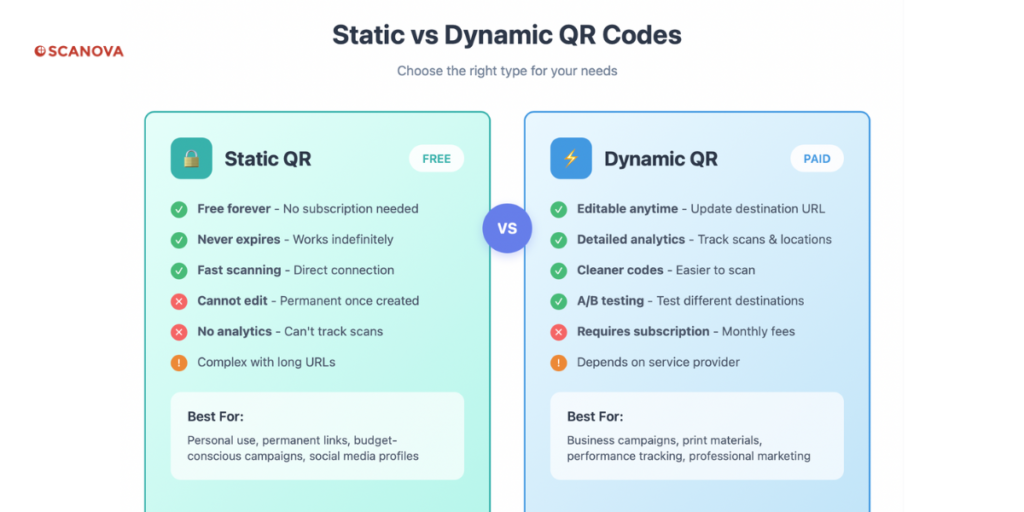
- Static QR Codes contain fixed information encoded directly into the code structure
- Dynamic QR Codes redirect to a URL that can be updated post-creation, enabling content changes without reprinting
The power of QR Code APIs lies in their ability to create dynamic codes that provide analytics, enable content updates, and integrate with existing business workflows.
B. What are some popular use cases of QR Codes API?
QR Code API can be used in practically any use case where you need to generate QR Codes in real-time. Here are some popular and common use cases:
1. Document authentication
QR Codes are now being extensively used for document authentication purposes.
You can generate the QR Codes that link to information in your database and add them to required documents.
2. Coupons
It is common for businesses to hand out coupons to give discounts. They help attract customers. But here’s the problem: customers have a hard time remembering the coupon codes due to the randomness of encoded characters.
But with QR Codes, they no longer need to remember the code. And with API, you can generate these coupon codes in real-time.
3. Visitor pass
Many institutions and organizations use visitor passes to allow visitor entry. And it’s common to spot a QR Code on them for security and authentication purposes.
For example, QR Code on a boarding pass. With QR Code API, you can enable QR Code generation smoothly for your visitor management process.
4. Product tags
You would’ve seen QR Codes on product packaging. Ever wondered what these are for?
They usually serve one of the two major purposes. The first is to provide product information that cannot be added to the limited printing space on the packaging.
The second is to encode product ID or serial number for inventory tracking and logistical operations.
Now, before we learn more about what QR Code APIs can do for your business, let’s compare some of the best QR Code API solution providers of 2025.
C. Comparison: Top QR Code API providers of 2025
Choosing the right QR Code API provider requires understanding each platform’s strengths, pricing models, and feature sets.
Here’s a comprehensive comparison of leading providers:
| Provider | Key Strengths | Pricing Model | Best For |
|---|---|---|---|
| Scanova | Enterprise security, 24+ QR Code categories, advanced analytics | Tiered subscription | Businesses needing branded, trackable QR Codes |
| QRCode Monkey | High customization, free tier available | Freemium | Small businesses and startups |
| Bitly | URL shortening integration, robust analytics | Subscription-based | Marketing-focused campaigns |
| QRTiger | White-labeling options, bulk generation | Enterprise pricing | Large-scale deployments |
| QuickChart | Developer-friendly, chart integration | Usage-based | Technical implementations |
Why Scanova leads the pack:
Scanova QR Code Generator stands out with its comprehensive feature set trusted by over 10,000 brands including Amazon, Nestlé, and Walmart.

The platform offers 24+ QR Code categories, enterprise-grade security (ISO 27001:2022, GDPR, SOC 2 compliant), and advanced analytics that provide actionable insights.

“The simplicity of this tool makes it easy for even non-tech users,” says Caitlyn Duffy from PepsiCo, highlighting Scanova’s user-friendly approach to QR Code API integration.
D. Key features every QR Code API should offer
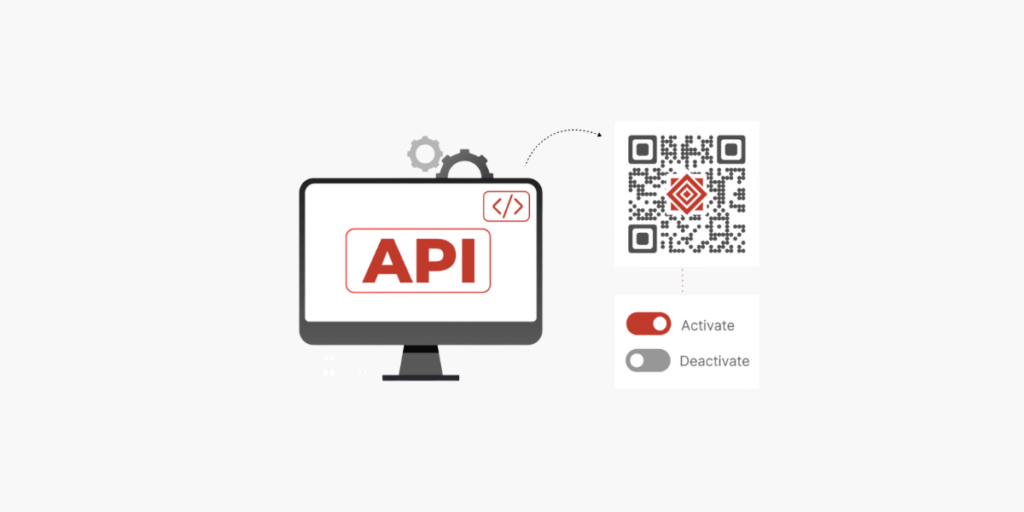
1. Customize QR Codes through APIs
Modern QR Code APIs provide extensive QR Code customization options that go far beyond basic black-and-white squares:
Design Customization:
- Brand colors and gradients
- Logo and design embedding with automatic error correction
- Custom frames and call-to-action text
- Various output formats (PNG, JPEG, SVG, PDF)
Scanova’s API allows you to create fully branded QR Codes that maintain scannability while reflecting your brand identity.
The platform automatically adjusts error correction levels when logos are embedded, ensuring reliable scanning across devices.
QR Code Categories: Scanova supports 24+ QR Code types, including:
- Website URLs and deep links
- Digital business cards (vCard)
- Wi-Fi network credentials
- App store redirections
- Event tickets and calendars
- Social media profiles
2. Offers dynamic QR Code generation via API
Dynamic QR Codes solve the fundamental problem of content updates without reprinting. Here’s how they work:
- Redirect Architecture: Dynamic codes point to a redirect service that can be updated
- Content Management: Change destinations, update information, or modify campaigns
- Campaign Optimization: Test different landing pages without new QR Code generation
- Cost Efficiency: Eliminate reprinting costs for marketing materials
3. Get insightful analytics via QR Code APIs
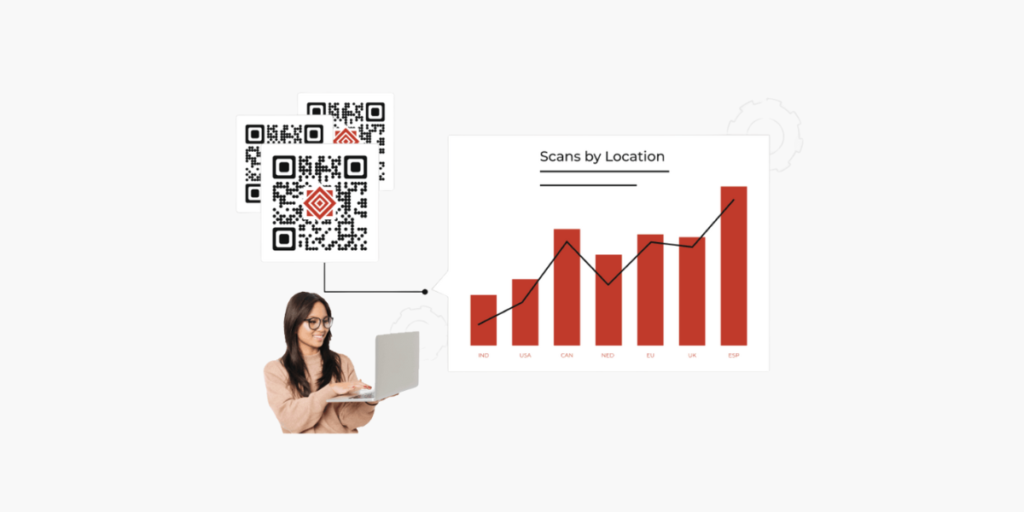
Comprehensive analytics separate professional QR Code APIs from basic generators:
Essential tracking metrics that you should look for:
- Scan count and frequency patterns
- Geographic location data
- Device and operating system information
- Time-based scanning trends
- Referrer source tracking
Advanced analytics features that always come in handy:
- Real-time dashboard updates
- Exportable reports and data visualization
- Google Analytics integration
- Conversion tracking and ROI measurement
- A/B testing capabilities for different destinations
“We have increased our leads by 10x with Scanova,” reports Daniela Gutierrez from Hitachi Vantara, demonstrating the power of analytics-driven QR Code campaigns.
4. Security considerations matter for QR Code APIs
Security becomes critical when QR Codes handle sensitive information or integrate with business systems:
Essential Security Features:
- Data Encryption: End-to-end encryption for QR Code content
- Access Controls: User permissions and role-based access
- Audit Logging: Complete activity tracking for compliance
- Compliance Standards: GDPR, SOC 2, ISO certifications
Scanova addresses these concerns with ISO 27001:2022 certification, GDPR compliance, and enterprise-grade security controls that protect both business data and customer privacy.
Ready to use QR Code APIs? Start with Scanova’s 14-day free trial to test enterprise features without commitment.
E. Best practices for QR Code API implementation
1. How can you optimize QR Code design for maximum scannability?
Design Principles:
- Contrast Ratio: Make sure there’s sufficient contrast between foreground and background
- Quiet Zone: Maintain clear space around the QR Code (minimum 4x module width)
- Size Requirements: Minimum 2×2 cm for reliable smartphone scanning
- Error Correction: Use appropriate levels when embedding logos
Testing Protocol:
- Test across multiple devices (iOS, Android, various camera qualities)
- Verify scanning under different lighting conditions
- Test both printed and digital display versions
- Validate with popular QR Code scanner apps
2. What are the most effective QR Code campaign strategies?

Multi-channel Integration:
- Combine QR Codes with email marketing for cross-channel engagement
- Use dynamic QR Codes to A/B test landing page effectiveness
- Implement progressive disclosure with multi-step QR experiences
Campaign Optimization Tactics:
- Weekly analytics review and destination adjustments
- Seasonal content updates using dynamic capabilities
- Geographic targeting based on scan location data
- Device-specific optimization for mobile vs. desktop experiences
“Scanova allows us to gauge interest in multiple distribution areas,” notes Marie Zecca from CWLOA, emphasizing the importance of geographic analytics for campaign optimization.
F. Type of QR Codes that can be generated via API
You can generate various types of static QR Codes programmatically via API. Here is a list of them:
1. Website URL QR Code
Do you want to take the end-users to a website when they scan the QR Code? Then Website URL QR Code is your way to go.
2. Text QR Code
As the name suggests, Text QR Code encodes text and numbers. It is used in a variety of use cases such as encoding the serial number of the product, product information, coupon codes, and terms and conditions.
3. Vcard QR Code
A Vcard or business card QR code API allows you to encode contact details. For example, your name, company name, contact number, email address, and fax number. When scanned, it shows the encoded content details to the end-users.
4. WiFi QR Code
The WiFi QR Code API helps create QR codes that, when scanned, allow end-users to join a particular Wi-Fi network.
It eliminates the need for end-users to manually type the password to access the WiFi network.
5. Google Maps QR Code
With Google Maps QR Code API, you can encode location coordinates into the QR Code in bulk.
When end-users scan it, they’ll be redirected to the location on the maps application on the phone.
6. Phone Call QR Code
Phone QR Code allows you to encode a phone number in it. When end-users scan it, they can readily give a call on the encoded number rather than having to manually type it.
7. Email QR Code
An email QR Code API allows you to encode the recipient’s email address in bulk and generate QR codes in real-time.
When end-users scan it, the email gets generated on their phone with the recipient’s address in the required field. They can then write the subject and email body to hit the send button.
8. SMS QR Code
Want your users to send a pre-drafted SMS to you? An SMS QR Code API can help you do it. When scanned, it loads a pre-drafted SMS along with the recipient’s phone number. It also allows the end-users to edit the SMS before sending it out.
9. Social Media QR Code
Whether you’re an employer, teacher, or agency, you might need to create bulk social media QR codes.
These codes can link to multiple social media profiles for different brands or people. In such cases, it’s a good idea to use an API for social media QR codes.
G. How to generate QR Codes via API
Now you know the types of QR Codes you can generate via API and their design potential. The next question is – how to create one?
To do that, you’ll need a suitable online bulk QR Code provider. Using Scanova’s QR Code API, here’s how you can proceed:
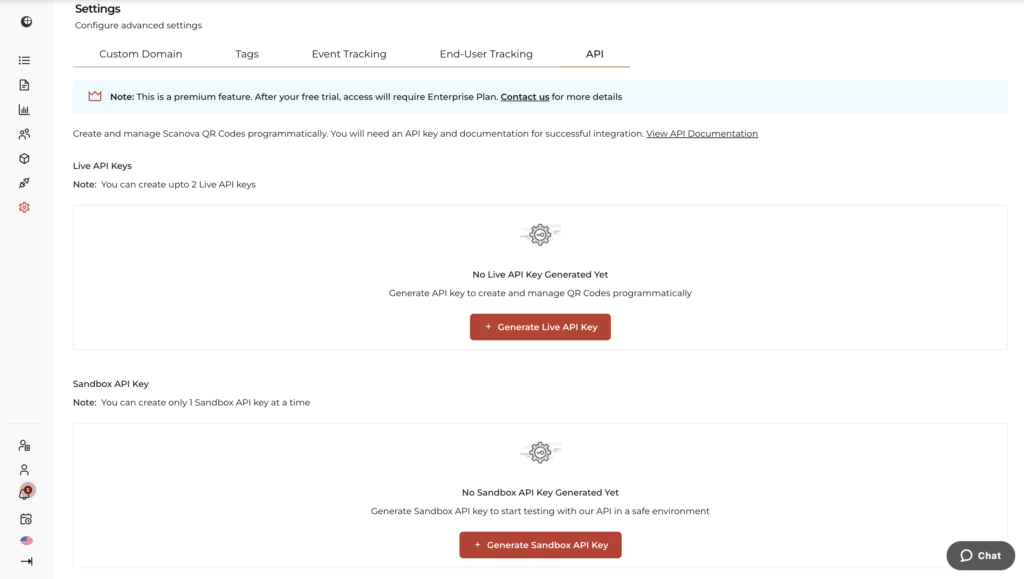
1. Log in to your Scanova account and go to Settings → API.
- There, you can generate a Live API Key (up to 2 at a time) and a Sandbox API Key (for testing with optional expiry).
2. Copy your API key. Click View API Documentation on that same page to load the Postman collection or in‑browser docs
3. Open the documentation and click the Authorize button. Paste in your API key when prompted, then click Authorize to authenticate your session.
4. Browse to the QR Code creation endpoint. Choose the category you need (e.g. Website URL, Payment link, etc.) and click Try it (Test).
5. In the request body, add the content you want to encode and specify design options like size, error correction level, logo, or colors.
6. Click Execute to send the API request. You’ll receive a response that shows cURL, Request URL, Response Body, and a preview image of the generated QR Code.
7. Copy the Response URL, which points to the QR Code image. Use it in your system or app to display or save the code.
8. Always scan-test the generated QR Code to ensure it works before integrating it into your production workflows.
H. Advanced QR Code API features for enterprise users of Scanova
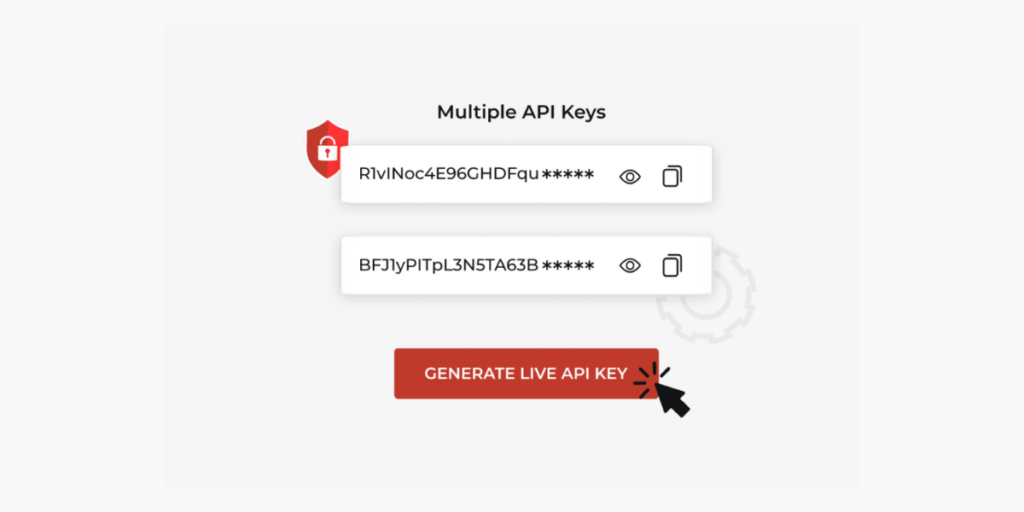
Team Collaboration Tools:
- User role management and permissions
- Shared QR Code libraries and templates
- Approval workflows for campaign launches
- Brand guideline enforcement
Advanced Integration Capabilities:
- CRM system synchronization for lead capture
- Marketing automation platform connections
- Custom domain support for branded short URLs
- Webhook notifications for real-time updates
Bonus White-labeling and Custom Solutions: Scanova offers white-labeling options for businesses that need QR Code functionality under their own brand, including custom API endpoints and branded user interfaces.
I. FAQs about QR Code APIs
1. What is the difference between static and dynamic QR Codes?
Static QR Codes contain information directly encoded in the code structure, making them unchangeable after creation.
Dynamic QR Codes redirect to a URL that can be updated, enabling content changes, analytics tracking, and campaign optimization without reprinting.
2. How secure is using a QR Code API for business?
Security depends on the provider’s infrastructure and compliance standards. Enterprise-grade solutions like Scanova offer ISO 27001:2022 certification, GDPR compliance, and encrypted data transmission.
Always verify security certifications and data handling practices before implementation.
3. Can QR Codes be branded with logos and colors?
Yes, modern QR Code APIs support extensive customization including brand colors, logo embedding, custom frames, and various design elements.
The API automatically adjusts error correction levels to maintain scannability when design elements are added.
4. What analytics are provided via QR Code APIs?
Comprehensive QR Code APIs provide scan counts, geographic data, device information, time-based trends, and conversion tracking.
Advanced platforms offer real-time dashboards, exportable reports, and integration with analytics tools like Google Analytics.
5. Is there a free QR Code API available?
Many providers offer free tiers with limited features, but enterprise-level functionality typically requires paid plans.
Scanova offers a 14-day free trial with full feature access, allowing businesses to evaluate API capabilities before committing to a subscription.
Conclusion
QR Code APIs have become essential infrastructure for businesses seeking to bridge offline and online experiences effectively.
From simple URL redirection to complex multi-channel marketing campaigns, the right API solution enables scalable QR Code operations with comprehensive analytics and enterprise-grade security.
The future of QR Codes lies in intelligent, data-driven implementations that provide measurable business value.
By choosing the right API platform and following best practices for implementation, businesses can unlock the full potential of QR Code technology for customer engagement, operational efficiency, and revenue growth.
Ready to transform your business with QR Code APIs? Start your free 14-day Scanova trial today and experience enterprise-grade QR Code generation with comprehensive analytics and customization options.
That’s it. That is all you need to know about how QR Codes are generated programmatically via API. You can now go ahead and generate your own QR Codes integrated with your system or mobile application.
